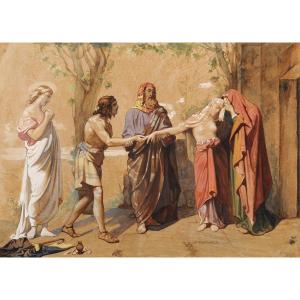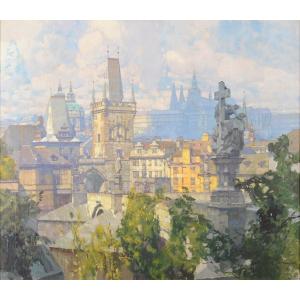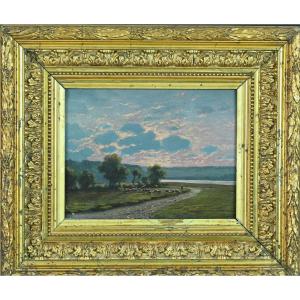(Ivry sur Seine 1846 - Paris 1899)
Sunset at Cernay la Ville or The Return of the Geese
Oil on canvas
H. 54 cm; W. 73 cm
Signed, located and dated lower left "Cernay la Ville, November 1891"
Henri Saintin successfully attended the workshops of Isidore Pils, Alexandre Ségé and Charles Saint Marcel at the École des Beaux-Arts, somewhat against his father's wishes. A family friend, Cointepoix de Blay (painter and deputy mayor of the 13th arrondissement in Paris), encouraged him and it took his success in the Troyon competition, where he won first prize in 1871, to overcome the resistance of a father, a wealthy merchant, who could not understand why he would devote his youth to such an uncertain profession. He took his first steps as a painter at the Salon in 1867 with the canvas: "Mare en sous-bois au Val-Saint-Germain en hiver". He went to paint in the surroundings of Paris and in the forest of Fontainebleau. Then around 1875, under the influence of Francis Blin and Alexandre Ségé, he discovered Brittany, whose landscapes became recurrent in his work. There he practiced watercolors which he used in pure tones. He settled in Plurien, near Cap Fréhel and often worked in Erquy, Saint-Cast, Paimpol, or Saint-Quay-Portrieux. He also made a stay, in 1875, in Saint-Quay. In 1890, Henri Saintin was one of the dissident artists at the origin of the split of the institution of the Salon into two exhibitions and until his death in 1899, he exhibited at the Salon of the National Society of Fine Arts. His last years also saw a diversification of his production: there are a few portraits, a religious scene, the Flight into Egypt (1893) and the sporadic introduction of the human figure in paintings with vague titles such as Autumn Evening (1892). His career remained discreet, even if he received commissions for decorations for the Luxembourg and the Hôtel de Ville, due to a modesty and a horror of advertising that pushed him to keep his works. In the field of urban landscape, we know of some views of Venice and rare views of Paris, including the small panel of the François-Gérard Seligmann donation ("View of the Universal Exhibition of 1889, in Paris"). In this painting he focuses on a vision of an ephemeral Paris which for a few months had seen dozens of palaces with capricious shapes appear, seeming to float on the water. Long stays in Brittany and the Côte-d'Or, studies of Paris and its suburbs, then a trip to Italy, had made him appreciate beautiful lines and clear, colorful light; he is indeed of the school of Corot, Troyon, Rousseau, Daubigny; he already possessed the accuracy of drawing to which he added the accuracy of tone and the sincere and broad execution of the modern school of landscape. Henri Saintin arrived well prepared for the exhibitions, so he obtained mentions and medals quite quickly, even, in Munich, at the International Exhibition of 1883, it was a path towards higher rewards. He obtained the Knight's Cross of the Legion of Honor in 1891. Henri Saintin produced an important body of work that places him in a good rank in modern landscape painting, in the phalanx of Chintreuil, Desbrosses, Lépine, Paul Guigou, Lansyer, etc. He exhibited for twenty-five years. His modesty, this need to preserve his works, limited his reputation and accumulated the productions in his studio. He always sought and chose the harmoniously composed site, even in his small panels and there are many; the drawing is observed with scrupulous care, the color just right and the effect captured with happiness. They give the impression of a vision of nature. Text by Jacques Riand In 1891, Henri Saintin produced this very beautiful work with a glowing palette. The geese have been brought in by their keepers and take on bluish hues in this late year setting sun. The thatched farm in the background is blocked by a bare tree, building the depth of the work. This canvas with its very particular light is among Saintin's most beautiful canvases.






































 Le Magazine de PROANTIC
Le Magazine de PROANTIC TRÉSORS Magazine
TRÉSORS Magazine Rivista Artiquariato
Rivista Artiquariato